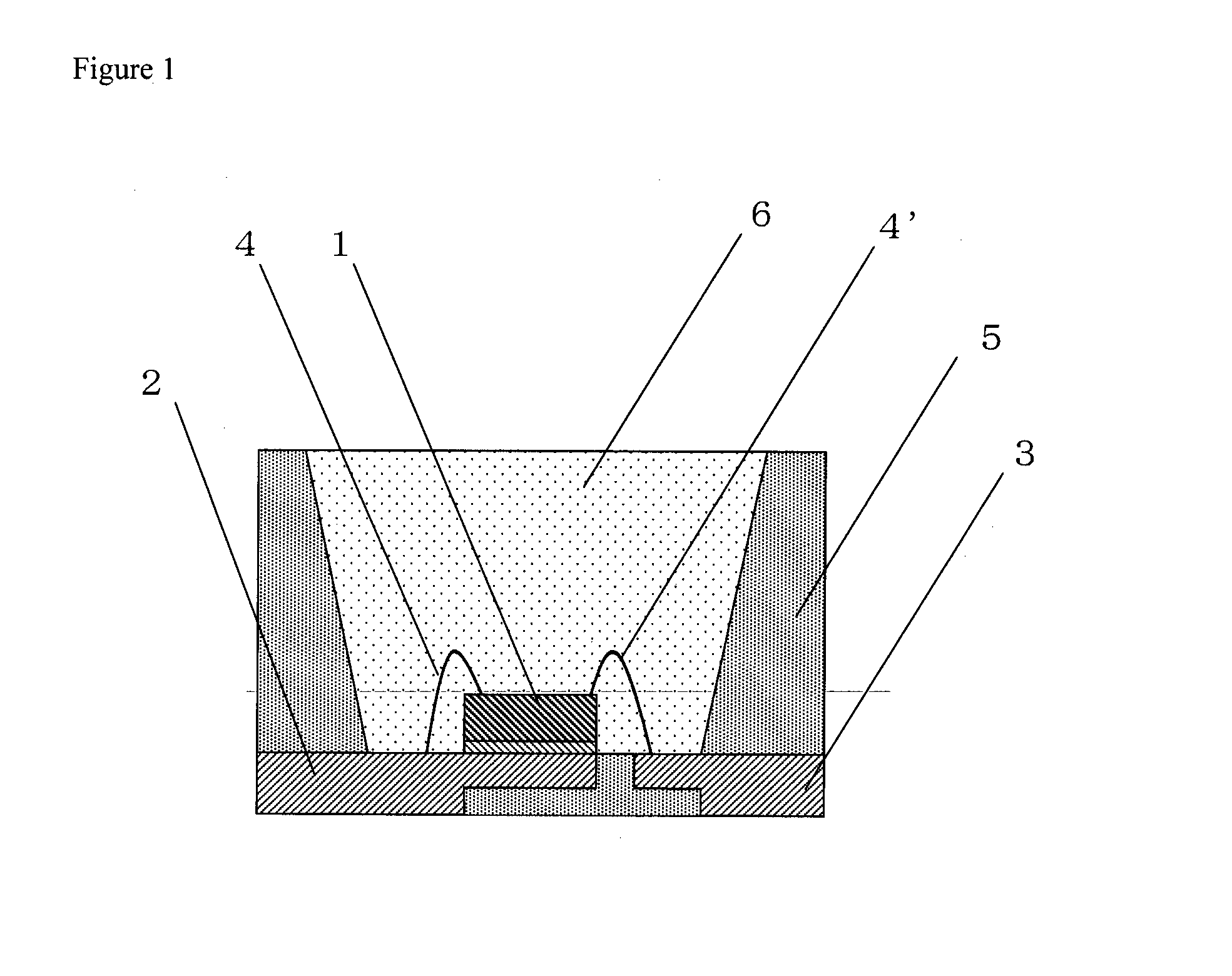Reactive Silicone Composition, Reactive Thermoplastic Article, Cured Product, And Optical Semiconductor Device
a technology of reactive thermoplastic articles and reactive silicone, which is applied in the direction of solid-state devices, organic chemistry, chemistry apparatus and processes, etc., can solve the problems of slow cure rate, compositions with further problems, poor mold release performance, etc., and achieve low discoloration or lowering of mechanical strength, high light reflectance, and high luminous efficiency
- Summary
- Abstract
- Description
- Claims
- Application Information
AI Technical Summary
Benefits of technology
Problems solved by technology
Method used
Image
Examples
example 1
Practical Example 1
[0068]100 parts by mass of methylvinylphenylpolysiloxane represented by the average unit formula:
(MeViSiO2 / 2)0.25(Ph2SiO2 / 2)0.30(PhSiO3 / 2)0.45(HO1 / 2)0.02
13.3 parts by mass of dimethylvinylsiloxy-terminated polymethylphenylsiloxane represented by the average formula:
ViMe2SiO(MePhSiO)17.5SiViMe2
33.3 parts by mass of 1,1,5,5-tetramethyl-3,3-diphenyltrisiloxane represented by the formula:
(HMe2SiO)2SiPh2
(in an amount that provided 1.15 moles of silicon atom-bonded hydrogen atoms in this component per 1 mol of total vinyl groups in the above-mentioned methylvinylphenylpolysiloxane and dimethylvinylsiloxy-terminated polymethylphenylsiloxane), a 1,3-divinyl-1,1,3,3-tetramethyldisiloxane solution of a platinum-1,3-divinyl-1,1,3,3-tetramethyldisiloxane complex (used in the composition in such an amount that in terms of mass units the content of the metallic platinum in this complex was 5.0 ppm), 1-ethynyl-1-cyclohexanol (used in the composition in such an amount that in ...
example 2
Practical Example 2
[0072]48.4 parts by mass of methylvinylphenylpolysiloxane represented by the average unit formula:
(MeViSiO2 / 2)0.25(Ph2SiO2 / 2)0.30(PhSiO3 / 2)0.45(HO1 / 2)0.02
51.6 parts by mass of methylvinylphenylpolysiloxane represented by the average unit formula:
(Me2ViSiO1 / 2)0.20(PhSiO3 / 2)0.80(HO1 / 2)0.01
0.02 parts by mass of epoxy group-containing polysiloxane represented by the average unit formula:
(Me2ViSiO1 / 2)0.2(MeEpSiO2 / 2)0.25(PhSiO3 / 2)0.55(HO1 / 2)0.005
12.9 parts by mass of dimethylvinylsiloxy-terminated polymethylphenylsiloxane represented by the average formula:
ViMe2SiO(MePhSiO)17.5SiViMe2
29.0 parts by mass of 1,1,5,5-tetramethyl-3,3-diphenyltrisiloxane represented by the formula:
(HMe2SiO)2SiPh2
(in an amount that provided 0.96 moles of silicon atom-bonded hydrogen atoms in this component per 1 mol of total vinyl groups in the above-mentioned methylvinylphenylpolysiloxanes and dimethylvinylsiloxy-terminated polymethylphenylsiloxane), a 1,3-divinyl-1,1,3,3-tetramethyldisi...
example 3
Practical Example 3
[0076]48.4 parts by mass of methylvinylphenylpolysiloxane represented by the average unit formula:
(MeViSiO2 / 2)0.25(Ph2SiO2 / 2)0.30(PhSiO3 / 2)0.45(HO1 / 2)0.02
51.6 parts by mass of methylvinylphenylpolysiloxane represented by the average unit formula:
(Me2ViSiO1 / 2)0.20(PhSiO3 / 2)0.80(HO1 / 2)0.01
12.9 parts by mass of dimethylvinylsiloxy-terminated polymethylphenylsiloxane represented by the average formula:
ViMe2SiO(MePhSiO)17.5SiViMe2
29.0 parts by mass of 1,1,5,5-tetramethyl-3,3-diphenyltrisiloxane represented by the formula:
(HMe2SiO)2SiPh2
(in an amount such that provided 0.96 moles of silicon atom-bonded hydrogen atoms in this component per 1 mol of total vinyl groups in the above-mentioned methylvinylphenylpolysiloxanes and dimethylvinylsiloxy-terminated polymethylphenylsiloxane), 0.04 parts by mass of 1,3,5,7-tetramethyltetracyclosiloxane (in an amount that provided 0.0037 moles of silicon atom-bonded hydrogen atoms in this component per 1 mol of total vinyl groups ...
PUM
| Property | Measurement | Unit |
|---|---|---|
| mol % | aaaaa | aaaaa |
| mol % | aaaaa | aaaaa |
| mol % | aaaaa | aaaaa |
Abstract
Description
Claims
Application Information
 Login to View More
Login to View More - R&D
- Intellectual Property
- Life Sciences
- Materials
- Tech Scout
- Unparalleled Data Quality
- Higher Quality Content
- 60% Fewer Hallucinations
Browse by: Latest US Patents, China's latest patents, Technical Efficacy Thesaurus, Application Domain, Technology Topic, Popular Technical Reports.
© 2025 PatSnap. All rights reserved.Legal|Privacy policy|Modern Slavery Act Transparency Statement|Sitemap|About US| Contact US: help@patsnap.com


